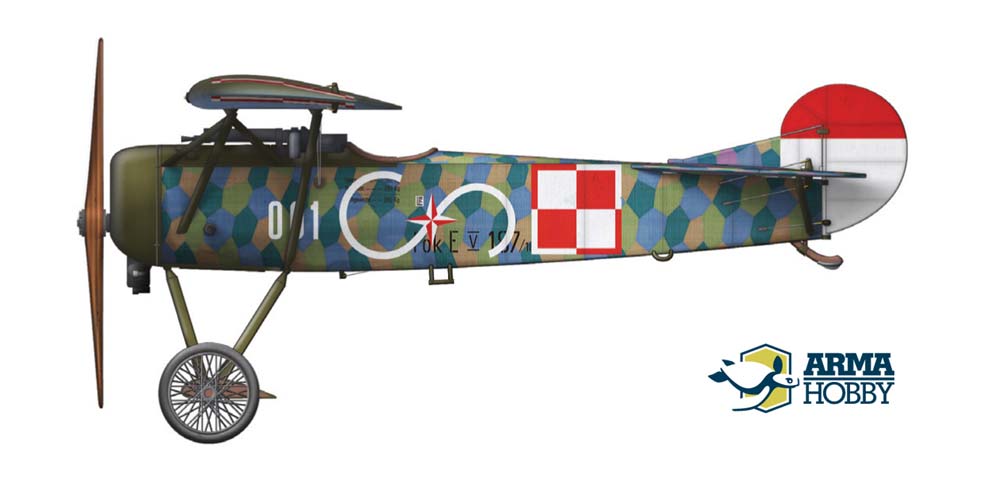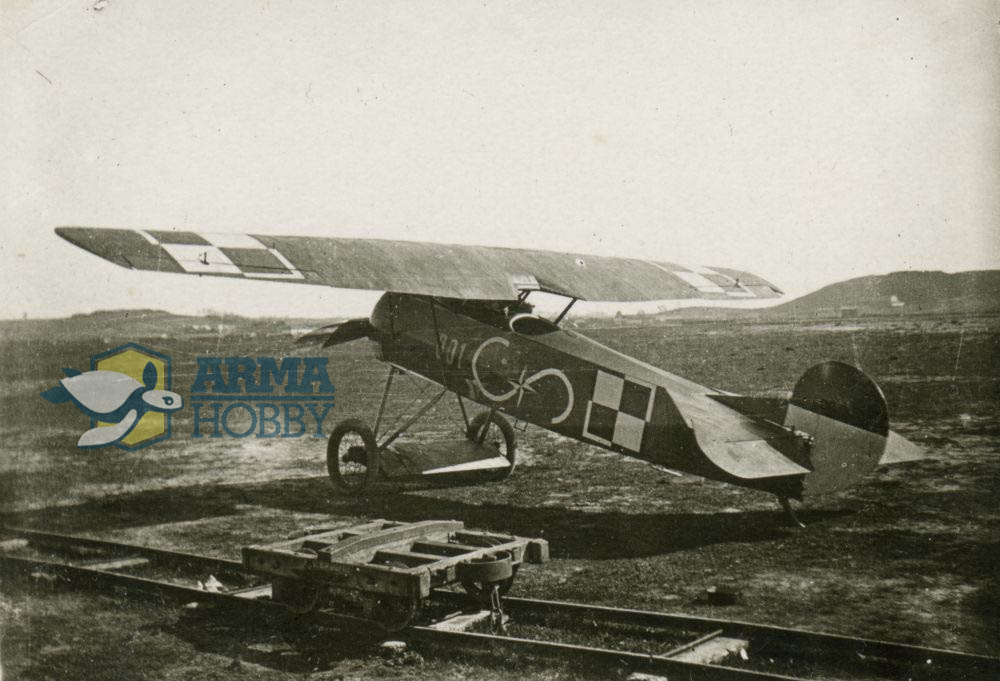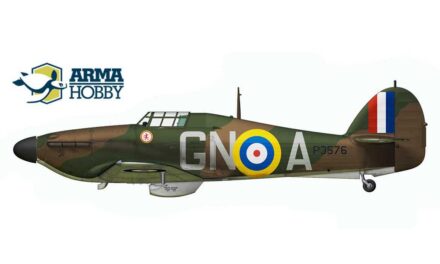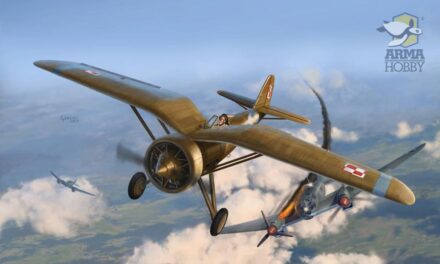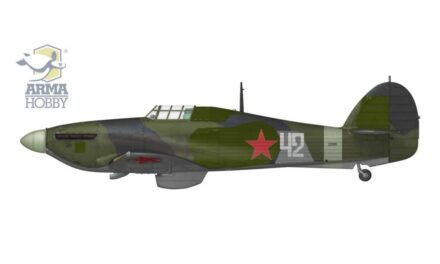Polish military aviation has been created and started to fight even before official restoration of the Polish State independence. Already in the first days of November 1918 in Cracow, Warsaw, Lwów, Przemyśl and in other places the Poles captured the German and Austrian airplanes, aviation equipment and infrastructure: airfields and workshops. First combat flights have been performed a week before 11th November, during fights against Ukrainians in the City of Lwów. While very effective, these activities were initially more spontaneous than organized and their scale was limited due to the equipment availability. Situation have changed radically in the January 1919 thanks to capturing of the several hundreds airplanes stored by the Germans in Poznań-Ławica and Winiary airbases.
Fokker E.V Polish CWL number 001, German military number 187/18, Werknummer 2828, immediately after arrival from Warsaw to Lwów 5th April 1919.
From Western Front to the East
In the vast loot captured 6th January in Poznań there were also most modern Fokker E.V fighters, produced in the Summer 1918. A few of them on 14th January were sent to the Warsaw Centralne Warsztaty Lotnicze (Central Aviation Workshops – CWL).
Assembled and tested in Warsaw-Pole Mokotowskie airfield, the Fokkers got the Polish national markings: white-and-red checkerboards with outlines (in Poznań the outlines were not applied at that time) replacing the scraped or washed German crosses. Photographs prove that the checkerboards were applied with various orientation and on one airplane two variants are clearly visible: with the top left field white (on the fuselage) and with the top left field red (on the rudder and the wing). It is possible that such lack of consequence has been caused by the fact that the plane has been painted before assembly, or simply in such early period the rule has not yet been fully established.
Fokker 001
In Warsaw the fighters have been assigned the military type number 00 and, after a dot (or without a dot), a number of the particular airframe. Such introduced system of the airplane numbering was used officially till the 1939 (for example PZL P.7 were numbered 7. and PZL P.11 – 8.). The number 001 (without a dot) has been assigned to the airplane marked with 187/18 German military number and 2828 Werknummer (German Fokker factory number). The German numbers have not been removed. Polish number was painted free-hand (note the slightly odd shape of the “1”), while the original German numbers had been applied with the use of stencils.
Polish number 001 and German military number 187/18 of the Fokker E.V in the “Warsaw” version, before repainting in Lwów
After arrival to the besieged City of Lwów on the 5th April the airplane had been quickly assembled and tested and on the following day has been assigned to the 7. Eskadra Lotnicza (7 Aviation Squadron), where it was immediately used in the pursuit of the enemy airplane by Lt. Stefan Stec, excellent fighter pilot, veteran of the Austro-Hungarian aviation of the Great War and creator of the Polish checkerboard national marking. Fokkers used in Lwów were quite quickly repainted in the local, traditional “Lwów” markings, including red and white tails instead of the rudder checkerboards and the pilot’s personal markings were applied.
Stefan Stec’s Fokker 001 repainted in “Lwów” markings and with pilot’s personal sign. City of Lwów, end of April 1919.
The 001 airplane assigned to Stefan Stec has been marked with the big white horizontal letter “S”, with white and red compass rose in the middle. The “Warsaw-style” number 001 has been repainted with bigger and more straight font and moved forward to make a room for the personal marking. On the better quality photographs some interesting details can be seen: thin auxiliary line under the digits used by the painter and washed “shadows” of the previous “Warsaw” 001.
New, “Lwów-style” number 001 with visible auxilliary line
It is interesting that the part of the “Warsaw-style” 001 number has been covered with the printed fabric (“lozenge”) patch.
„Shadow” of the washed „Warsaw-style” number with „lozenge” patch.
The airplane has got the Polish markings but the camouflage remained original German. The fuselage, tailplane, fin and rudder were covered with the printed fabric (“lozenge”). Interesting that the fuselage was covered with 4-colours scheme but the tailplane, fin and rudder – with the 5-colour scheme.
 Colours and markings of the Fokker. E.V flown by Stec from Lwów. Fuselage was covered with four-colour Lozenge pattern, Tailplanes with five-colour Lozenge patterns.
Colours and markings of the Fokker. E.V flown by Stec from Lwów. Fuselage was covered with four-colour Lozenge pattern, Tailplanes with five-colour Lozenge patterns.
All the metal parts (wing struts, undercarriage legs, engine cover) and the plywood-covered little ‘wing’ streamlining the wheel-axle remained in original German olive-green paint. Also the wing was in original German colours – read the detailed article about the design and the camouflage of the Fokker E.V wing. It is interesting that the remaining parts of the washed or scraped German crosses were visible on the wing.
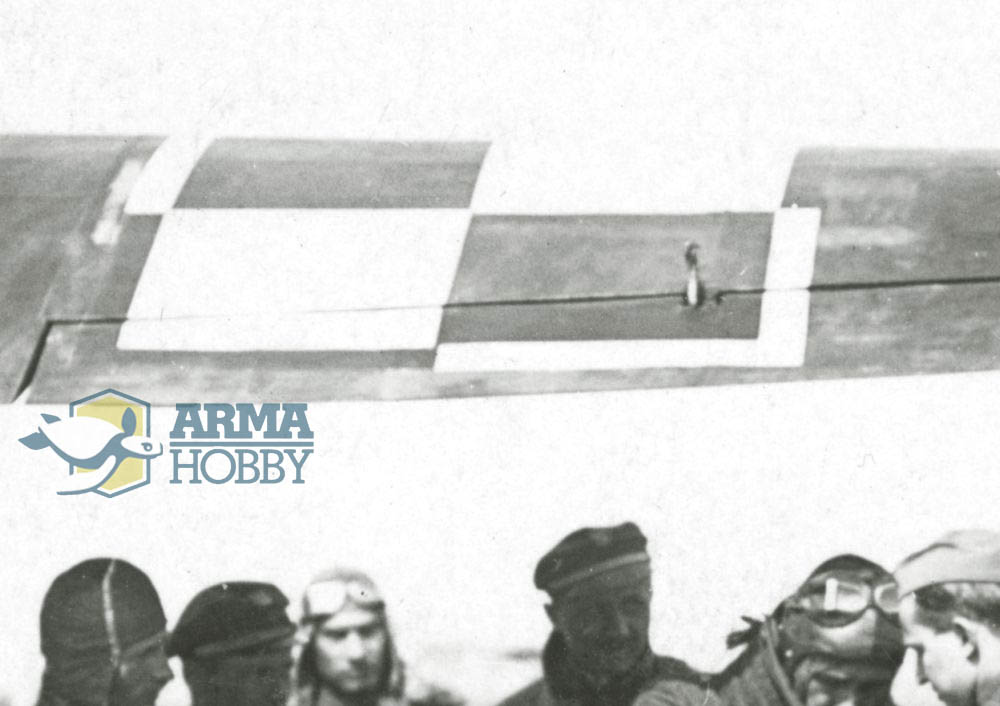 German crosses – scraped or washed – visible on the wing
German crosses – scraped or washed – visible on the wing
In combat
Fokker E.V 001 has been very actively used in 7. Eskadra as a fighter and a ground attack, piloted by Stefan Stec. In April it performed 11 operations, including victorious air combat on 29 April against former Austrian aviation ace Franz Rudorfer, flying in Ukrainian service on the Nieuport 23.
Fokker E.V 001 on 20th April after the operational sortie, already in „Lwów markings”. The pilot, Stefan Stec in overall and goggles is looking at the dog. Left of Stec, in a side cap, stands US aviator Merian Cooper, future creator and one of the pilots of the famous Kościuszko Squadron.
In May 1919 the air fights became less intense, as the front moved eastwards and the light Fokkers had limited operational range. The documents prove only one attack against enemy observation balloon (10th May) and ground attack sortie on 14th May. Later the airplane was no longer used operationally, while it was still fully airworthy till the May 1920, when it was dismantled and sent by train to Warsaw. Later history of this famous airplane is not known.
All the photographs presented in this article – from the Tomasz Kopański collection – show the same airplane: Stefan Stec’s Fokker E.V 001, German military number 187/18, factory number (Werknummer) 2828.
 Advertisement
Advertisement
Models of the Fokkera E.V, including Ltn. S. Stec markings (70012) you will find in Arma Hobby internet shop here
Modeller happy enough to work in his hobby. Seems to be a quiet Aspie but you were warned. Enjoys talking about modelling, conspiracy theories, Grand Duchy of Lithuania and internet marketing. Co-founder of Arma Hobby. Builds and paints figurines, aeroplane and armour kits, mostly Polish subject and naval aviation.
This post is also available in:
 polski
polski


